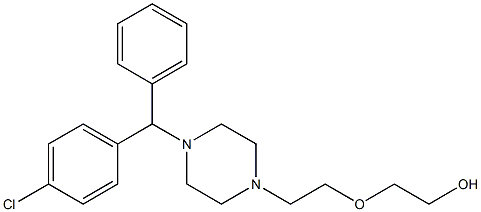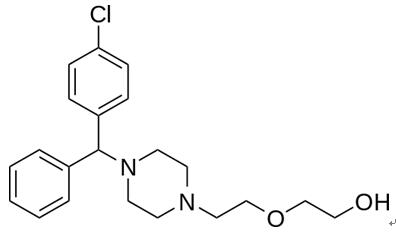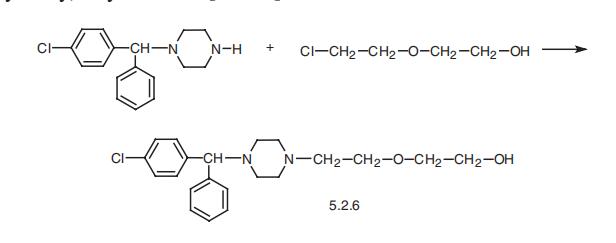- Equipoise
-

- $0.00 / 1KG
-
2024-03-16
- CAS:
- Min. Order: 100g
- Purity: 98%+
- Supply Ability: 100kg
- Hydroxyzine USP/EP/BP
-

- $1.10 / 1g
-
2021-07-23
- CAS:68-88-2
- Min. Order: 1g
- Purity: 99.9%
- Supply Ability: 100 Tons min
- Hydroxyzine
-

- $15.00 / 1KG
-
2021-07-13
- CAS:68-88-2
- Min. Order: 1KG
- Purity: 99%+ HPLC
- Supply Ability: Monthly supply of 1 ton
|
| Product Name: | Hydroxyzine | | Synonyms: | �1-(p-Chloro-a-phenylbenzyl)-4-[2-(2-hydroxyethoxy)ethyl)]piperazine;NSC 169188;1-(p-Chloro-α-phenylbenzyl)-4-[2-((2-hydroxyethoxy)ethyl)]piperazine;2-[2-[4-(p-Chloro-α-phenylbenzyl)-1-piperazinyl]ethoxy]ethanol;Ethanol, 2-[2-[4-(4-chloro-α-phenylbenzyl)-1-piperazinyl]ethoxy]- (6CI);Ethanol, 2-[2-[4-(p-chloro-α-phenylbenzyl)-1-piperazinyl]ethoxy]- (8CI);Hydroxyzine (base and/or unspecified salts);EQUIPOISE / HYDROXYZINE | | CAS: | 68-88-2 | | MF: | C21H27ClN2O2 | | MW: | 374.9 | | EINECS: | 200-693-1 | | Product Categories: | Aromatics;Heterocycles;Intermediates & Fine Chemicals;Pharmaceuticals | | Mol File: | 68-88-2.mol |  |
| | Hydroxyzine Chemical Properties |
| Melting point | 190°C | | Boiling point | 250 °C(Press: 0.1 Torr) | | density | 1.1020 (rough estimate) | | refractive index | 1.5400 (estimate) | | storage temp. | 2-8°C | | solubility | Chloroform (Slightly), DMSO (Sparingly), Ethanol (Slightly), Methanol (Slightly, | | form | Oil to Gel | | pka | pKa 1.96± 0.05;7.40± 0.03(H2O,t =24.5±0.5)(Approximate) | | color | Colourless to Yellow | | Water Solubility | < 700 mg/mL | | BCS Class | 2 | | NIST Chemistry Reference | Hydroxyzine base(68-88-2) | | EPA Substance Registry System | Hydroxyzine (68-88-2) |
| | Hydroxyzine Usage And Synthesis |
| Overview | Hydroxyzine hydrochloride, a member of the piperazine class of H1 receptor antagonists[1] is a strong antipruritic and anti-whealing[2-4] agent and is often recommended as the antihistamine of choice in the treatment of allergic skin disorders[5-7]. It is also effective in the treatment of allergic rhinitis[8, 9] and has some bronchodilator properties when used alone or in combination with other bronchodilators[10-12].
Like other "classic H, antihistamines," the central nervous system(CNS) effects of hydroxyzine are well appreciated and can at times make the daytime treatment of allergic conditions difficult. The most common CNS side effect of hydroxyzine is sedation, and probably an actual impairment of cognitive function, because most studies use psychomotor testing to quantitate these CNS effects[13, 14]. The pharmacologic mechanism for this CNS effect remains poorly understood. Much interest has been paid to the development of "nonsedating" antihistamines. There had been frequent claims of relatively less sedation, but in many cases such studies do not demonstrate that doses devoid the CNS effects are capable of producing adequate antiallergic effects. Recent data with newer agents challenge the long-held concept that sedation was an inseparable component of classic antihistaminic effects. These newer agents tend to have a smaller volume of distribution (Varea) in the body, and some suggest that lower CNS penetration is responsible for the lower incidence of CNS effects.

Figure 1 Chemical structure of hydroxyzine | | Indication | Hydroxyzine is used for the treatment of anxiety disorder as well as being used in other more serious cases as psychoneurosis. Therefore, it is prescribed as a means of regulating normal function. Hydroxyzine has shown to be as effective as the benzodiazepine drug bromazepam in the treatment of generalised anxiety disorder[15]. A systematic review found that hydroxyzine is as excellent as other anxiolytic agents[benzodiazepines and buspirone] in efficacy, acceptability, and tolerability[16]. Hydroxyzine can also be used for the treatment of allergic conditions including chronic urticaria, atopic or contact dermatoses, and histamine-mediated pruritus. Studies have found no adverse effects on the liver, blood, nervous system, or urinary tract[17].
| | Mode of action | Hydroxyzine taking effect through acting as the competitor of histamine for binding at H1-receptor sites on the effector cell surface, further leading to suppression of histaminic edema, flare, and pruritus[18]. The sedative properties of hydroxyzine occur at the subcortical level of the CNS. Secondary to its central anticholinergic actions, hydroxyzine may also be effective as an antiemetic. Since hydroxyzine has very low affinity for the muscarinic acetylcholine receptors, it has low or no propensity for producing anticholinergic side effects[19][20][21]. In addition to its antihistamine activity, hydroxyzine is also capable of acting more weakly as an antagonist of the serotonin 5-HT2A receptor, the dopamine D2 receptor, and the α1-adrenergic receptor[22]. The weak antiserotonergic effects of hydroxyzine likely underlie its usefulness as an anxiolytic,[23] as other antihistamines without such properties have not been found to be effective in the treatment of anxiety[24].
| | Pharmacokinetics | Hydroxyzine, a piperazine antihistamine structurally related to buclizine, cyclizine, and meclizine, being for the treatment of histamine-mediated pruritus or pruritus due to allergy, nausea and vomiting, and, in combination with an opiate agonist, anxiolytic pain. Hydroxyzine can also be used as a perioperative sedative and anxiolytic and to manage acute alcohol withdrawal. Hydroxyzine's active metabolite, cetirizine, is also used as an H1-antagonist. The 0.7-mg/kg oral dose of hydroxyzine produced a mean peak serum concentration of 72.5 mg/ml at a mean time of 2.1 hr. The mean elimination half-life calculated from the terminal linear portion of the curves was 20.0 hr. The mean clearance rate, 9.78 ml/min/kg, and mean apparent volume of distribution, 16.0 L/kg, were also calculated by nonparametric methods.
In a study of the disposition of tritiated hydroxyzine in rats, 40% to 42% of the radioactivity was excreted within 24 hr, largely in the feces via the bile and in the urine. Hydroxyzine was rapidly distributed to all organs studied, with the highest activity being found in the lungs, fat, liver, spleen, and kidneys. The drug appeared to be completely metabolized, since less than 2% of the radioactivity as unchanged drug was recovered in the urine or feces. About 16% of the dose of radioactivity was recovered in urine over 5 days. Of this, 7% was identified as p-chlorobenzophenone, p-chlorobenzhydrol, and p-chlorop’-hydroxybenzophenone, 15% as pchlorobenzhydrol and p-chloro-p’-hydroxybenzophenone glucuronides, and 5% as piperazine and 2-[2-[1-piperazinyl]-ethoxyl] ethanol[25].
| | Adverse reactions | Several side effects including deep sleep, incoordination, sedation, calmness, and dizziness have been reported in children and adults, as well as others such as hypotension, tinnitus, and headaches[27]. Gastrointestinal effects have also been observed, as well as less serious effects such as dryness of the mouth and constipation caused by the mild antimuscarinic properties of hydroxyzine[27].
Adverse reactions may also occur rarely to central nervous system including hallucinations or confusion, being attributed mostly to overdosage[27, 28]. Such properties have been attributed to hydroxyzine in several cases, particularly in patients treated for neuropsychological disorders, as well as in cases where overdoses have been observed. While there are reports of the "hallucinogenic" or "hypnotic" properties of hydroxyzine, several clinical data trials have not reported such side effects from the sole consumption of hydroxyzine, but rather, have described its overall calming effect described through the stimulation of areas within the formatio reticularis. The hallucinogenic or hypnotic properties have been described as being an additional effect from overall central nervous system suppression by other CNS agents, such as lithium or ethanol[29].
| | Precaution | The following tips should be following when you use hydroxyzine[30]. You should not use hydroxyzine in the following conditions, allergic to it/ you have long QT syndrome/ you are allergic to cetirizine(Zyrtec) or levocetirizine(Xyzal) you are in the first trimester of pregnancy. You should not use hydroxyzine if you are pregnant, especially during the first or second trimester. Hydroxyzine could harm the unborn baby or cause birth defects. You should use effective birth control to prevent pregnancy while you are using this medicine.
To make sure this medicine is safe for you, tell your doctor if you have: blockage in your digestive tract(stomach or intestines) bladder obstruction or other urination problems/ glaucoma/heart disease/slow heartbeats/personal or family history of long QT syndrome/ an electrolyte imbalance(such as high or low levels of potassium in your blood)/ if you have recently had a heart attack. It is not known whether hydroxyzine passes into breast milk or if it could harm a nursing baby. You should not breast-feed while using this medicine. Do not give this medicine to a child without medical advice.
| | Referrence |
- Rhoades RB, Leifer KN, Cohan R, Wittig HJ: Suppression of histamine-induced pruritus by three antihistaminic drugs. J ALLERGY CLIN IMMUNOL 55:180, 1975
- Cook TJ, MacQueen DM, Wittig HJ, Thomby Jl, Lantos RL, Virtue CM: Degree and duration of skin test suppression and side effects with antihistamines. J ALLERGY CLIN IMMUNOL 51:71, 1973
- Dundas E, Toogood JH, Wanklin J: Inhibition of experimental skin wheal by some ataractic and antihistaminic drugs. J ALLERGY 32:1, 1961
- Galant SP, Bullock J, Wong D, Maibach HI: The inhibitory effect of antiallergy drugs on allergen and histamine induced wheal and flare response. J ALLERGY CLIN IMMUNOL 51:ll.1973
- Baraf CS: Treatment of pruritus in allergic dennatoses: an evaluation of the relative efficacy of cyproheptadine and hydroxyzine. Curr Ther Res 19:32, 1976
- Klein GL, Galant SP: A comparison of the antipruritic efficacy of hydroxyzine and cyproheptadine in children with atopic dermatitis. Ann Allergy 44:142, 1980
- Matthews CNA, Kirby JD, James J, Warin RP: Dermographism: reduction in weal size by chlorpheniramine and hydroxyzine. Br J Dermatol 88:279, 1973
- Schaaf L, Hendeles L, Weinberger M: Suppression of seasonal allergic rhinitis symptoms with daily hydroxyzine. J ALLERGY CLIN IMMUNOL 63:129, 1979
- Wong L, Hendeles L, Weinberger M: Pharmacologic prophylaxis of allergic rhinitis: relative efficacy of hydroxyzine and chlorpheniramine. J ALLERGY CLIN IMMUNOL 67:223, 1981
- Bierman CW, Pierson WE, Shapiro GG: Exercise-induced asthma. Pharmacological assessment of single drugs and drug combinations. JAMA 234295, 1975
- Heurich A, Sousa-Poza M, Lyons HA: Bronchodilator effects of hydroxyzine hydrochloride. Respiration 29:135, 1972
- Brandon ML: Pirbuterol vs hydroxyzine vs theophylline vs placebo in the treatment of bronchial asthma. Ann Allergy 45:8, 1980
- Burns M, Moskowitz H. Effects of diphenhydramine and alcohol on skills performance. Eur J Clin Pharmacol 1980;17:259-66.
- Seppala T, Nuotto E, Korttila K. Single and repeated dose comparison of three antihistamines and phenylpropanolamine psychomotor performance and subjective appraisal of sleep. Br J Clin Pharmacol 1981;12:179-88.
- Llorca PM, Spadone C, Sol O, et al.[November 2002]. "Efficacy and safety of hydroxyzine in the treatment of generalized anxiety disorder: a 3-month double-blind study". J Clin Psychiatry. 63[11]: 1020–7.
- Giuseppe Guaiana1, Corrado Barbui, Andrea Cipriani[8 December 2010]. "Hydroxyzine for generalised anxiety disorder". The Cochrane Library. Cochrane Depression, Anxiety and Neurosis Group.
- United States Food & Drug Administration,[2004], p1
- https://www.drugbank.ca/drugs/DB00557
- Hosák, Ladislav; Hrdli?ka, Michal. Psychiatry and Pedopsychiatry. Charles University in Prague, Karolinum Press. pp. 364–. ISBN 978-80-246-3378-7.
- Berger, F. M.[1957]. "THE CHEMISTRY AND MODE OF ACTION OF TRANQUILIZING DRUGS". Annals of the New York Academy of Sciences. 67[10]: 685–700. doi:10.1111/j.1749-6632.1957.tb46006.x. ISSN 0077-8923.
- K. D. Tripathi[2013]. Essentials of Medical Pharmacology. JP Medical Ltd. p. 165. ISBN 978-93-5025-937-5.
- J. Szepietowski; E. Weisshaar. Itch Management in Clinical Practice. Karger Medical and Scientific Publishers. pp. 1–. ISBN 978-3-318-05889-5.
- Barbara Olasov Rothbaum; Stein, Dan J.; Hollander, Eric[2009]. Textbook of Anxiety Disorders. American Psychiatric Publishing, Inc. ISBN 1-58562-254-0.
- Lamberty Y, Gower AJ. "Hydroxyzine prevents isolation-induced vocalization in guinea pig pups: comparison with chlorpheniramine and immepip". Pharmacology Biochemistry and Behavior. 79[1]: 119–24. doi:10.1016/j.pbb.2004.06.015. PMID 15388291.
- Pong S F, Huang C L. Comparative studies on distribution, excretion, and metabolism of hydroxyzine-3H and its methiodide-14C in rats[J]. Journal of Pharmaceutical Sciences, 1974, 63[10]:1527-1532.
- Fouda H G, Hobbs D C, Stambaugh J E. Sensitive assay for determination of hydroxyzine in plasma and its human pharmacokinetics[J]. Journal of Pharmaceutical Sciences, 2010, 68[11]:1456-1458.
- UCB South-Africa, et al.,[2004]
- United States Food & Drug Administration,[2004], p3
- Anderson, P. O., Knoben, J. E., et al.[2002], p794-796
- https://www.drugs.com/hydroxyzine.html
| | Description | Hydroxyzine is an antihistamine drug with M-cholinoblocking properties and expressed
action on the CNS. It suppresses subcortical regions of the CNS including the limbic system
and reticular formation. It potentiates the effect of narcotic analgesics and exhibits
sedative effects. | | Chemical Properties | Yellow Oil | | Originator | Atarax,UCB,France,1956 | | Uses | It is used as a sympthomatic drug for atopic dermatitis as a sedative drug
before and after operational interventions, for preventing vomiting and diarrhea, and for
relieving agitation and emotional disorders. Synonyms of this drug are atarax, durrax, and
vistaril. | | Uses | H1 receptor antagonist. Anxiolytic. Antihistaminic. | | Uses | Hydroxyzine is intended for the symptomatic treatment of anxiety and stress associated
with neurosis as well as with conditions of organic illness. This drug has muscle relaxant,
antihistimine, analgesic, local anesthetic, and antiemetic action as well as a wide thera�peutic effect. It is mainly used in premedication and following general anesthesia, during
which it potentiates the action of meperidine and barbiturates. It is frequently used in pedi�atrics as a mild sedative drug. | | Definition | ChEBI: A N-alkylpiperazine that is piperzine in which the nitrogens atoms are substituted by 2-(2-hydroxyethoxy)ethyl and (4-chlorophenyl)(phenyl)methyl groups respectively. | | Indications | Drugs of choice for the treatment of dermatographism and cholinergic
urticaria. They are also effective alone or in combination with other antihistamines
in the management of acute and chronic urticaria, atopic and contact
dermatoses, and histamine-induced pruritus. It may be used alone or with other antihistamines, and dosage
should be pushed to the limit of tolerance or to subsidence of symptoms. | | Manufacturing Process | A mixture of 0.1 mol of N-mono-1-p-chlorobenzohydrylpiperazine and 0.1 mol
of 1-chloro-2-(2-hydroxy-ethoxy)-ethane is heated for 3 hours to 150°C. The
mass is then taken up in 100 ml of benzene and 100 ml of a 10% aqueous
solution of NaOH; decanting takes place, and the benzene solution is washed
with water and the solvent is evaporated. Vacuum distilling of the residue
yields 1-p-chlorobenzohydryl-4-[2-(2-hydroxy-ethoxy)-ethyl]-piperazine, BP
220°C/0.5 mm Hg.
The corresponding dihydrochloride is prepared by dissolving this base in about
twice its weight of alcohol, by treating it with excess of gaseous HCl and by
precipitating it with ether. The solvent is decanted and the residue, dissolved
in a minimum of alcohol, crystallizes on the addition of ether, MP 193°C. | | Brand name | Amplimexon
(Amplimed). | | Therapeutic Function | Tranquilizer | | Safety Profile | Poison by intravenous
and intraperitoneal routes. Moderately toxic
by ingestion. Experimental teratogenic and reproductive effects. When heated to
decomposition it emits very toxic fumes of
Cland NOx. | | Synthesis | Hydroxyzine, 2-[2-[4-(p-chloro-|á-phenylbenzyl)-1-piperazinyl]-ethoxy]
ethanol (5.2.6), is synthesized by the alkylation of 1-(4-chlorobenzohydril)piperazine with
2-(2-hydroxyotoxy)ethylchloride [56¨C61]. 
| | Dosage forms | 25 mg, three to four times a day. |
| | Hydroxyzine Preparation Products And Raw materials |
|